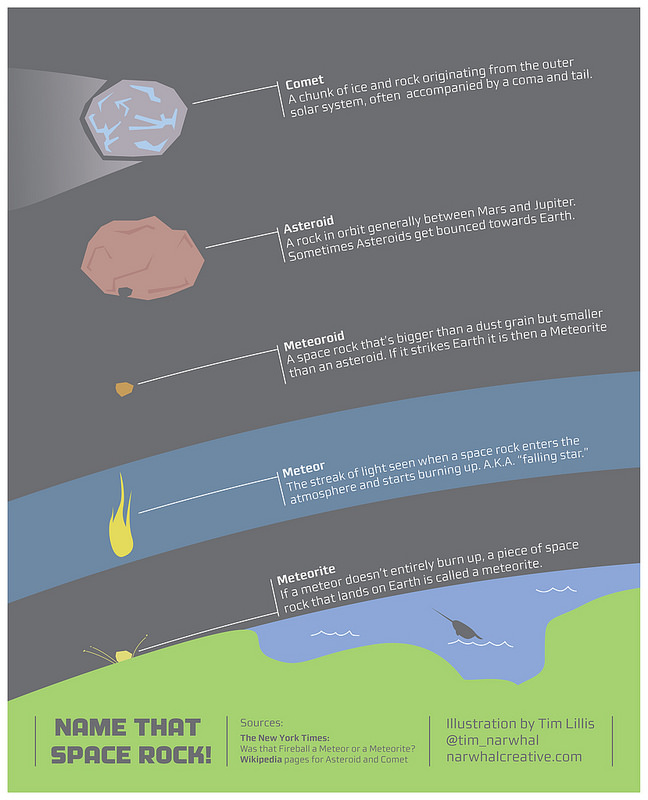With all the various space rocks flying by and into Earth last Friday, perhaps you’ve been wondering about the correct terminology, since a rock from space has different names depending on what it is made of and where it is.
Infographics artist Tim Lillis has put together a primer of sorts, in the form of an infographic, describing the different between a comet, asteroid, meteoroid, meteor and meteorite.
Asteroids are generally larger chunks of rock that come from the asteroid belt located between the orbits of Mars and Jupiter. Sometimes their orbits get perturbed or altered and some asteroids end up coming closer to the Sun, and therefore closer to Earth.
Comets are much like asteroids, but might have a more ice, methane, ammonia, and other compounds that develop a fuzzy, cloud-like shell called a coma – as well as a tail — when it gets closer to the Sun. Comets are thought to originate from two different sources: Long-period comets (those which take more than 200 years to complete an orbit around the Sun) originate from the Oort Cloud. Short-period comets (those which take less than 200 years to complete an orbit around the Sun) originate from the Kuiper Belt.
Space debris smaller than an asteroid are called meteoroids. A meteoroid is a piece of interplanetary matter that is smaller than a kilometer and frequently only millimeters in size. Most meteoroids that enter the Earth’s atmosphere are so small that they vaporize completely and never reach the planet’s surface. And when they do enter Earth’s atmosphere, they gain a different name:
Meteors. Another name commonly used for a meteor is a shooting star. A meteor is the flash of light that we see in the night sky when a small chunk of interplanetary debris burns up as it passes through our atmosphere. “Meteor” refers to the flash of light caused by the debris, not the debris itself.
If any part of a meteoroid survives the fall through the atmosphere and lands on Earth, it is called a meteorite. Although the vast majority of meteorites are very small, their size can range from about a fraction of a gram (the size of a pebble) to 100 kilograms (220 lbs) or more (the size of a huge, life-destroying boulder).
Thanks again to Tim Lillis for sharing his infographic with Universe Today. For more info about Tim’s work, see his Behance page, Flickr site, Twitter, or his website.


Space rocks need new definitions or classifications… At this moment there is no lower limit for asteroids. It doesn’t seem to me right putting a couple ten meter-wide space rock with a 100 kilometer-wide one in the same basket !
No room for bolide?
A primer on impacts: http://www.lpi.usra.edu/publications/books/CB-954/CB-954.pdf
This link should be sent to every main stream media outlet, and every movie producer in Hollywood!
So if a meteoroid becomes a meteor then a meteorite, what do asteroids and comets become when they strike the earth? Do they keep their original names, or do they adopt the meteor then a meteorite names? Maybe since they are so large, there would be no one left to name them – so it wouldn’t matter.
The term “meteoroid” is poorly defined here. It says a meteoroid is “smaller than an asteroid” and “is smaller than a kilometer.” Actually a 700 or 800 meter object would definitely fall in the “asteroid” category. There have been recent attempts to define a meteoroid as 1-meter or less, but right now there is no clear definition.
Soooo, every1 is worried about the names of space rocks in this graphic… but wth is that pointy thing in the water? A sub? with a speed sensor probe like the X15 or some other highspeed x-plane?
I think THAT is the main question here. Very narwhalian
Have you read that novel THE MYOSHI EFFECT? It’s almost like what just happened, about how people react when an asteroid heads toward earth. It’s based on science, but it’s written in a funny way.